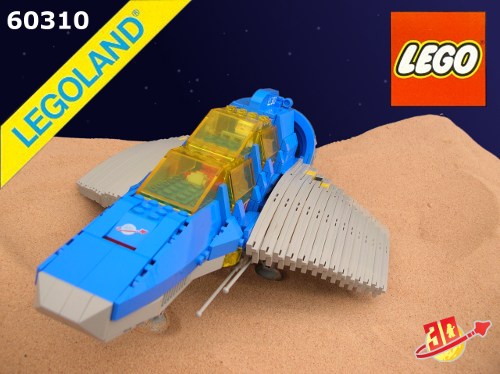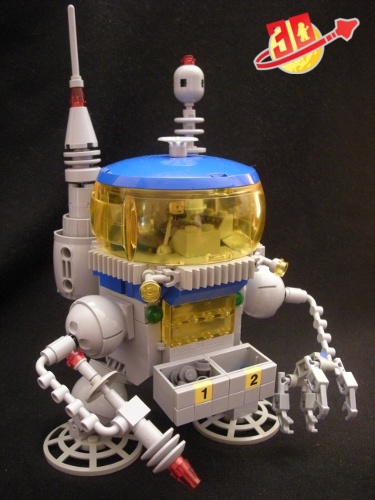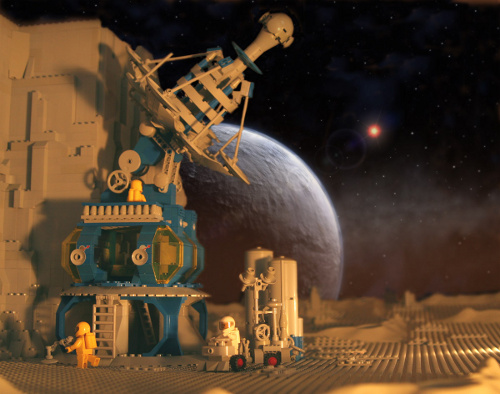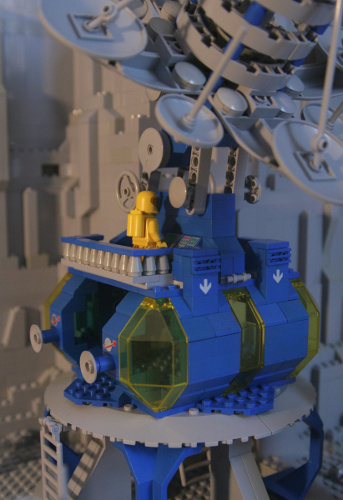james's blog
Day 24 Bonus: Deep Space Transceiver
24 March, 2009 - 23:16 — jamesAs a bonus for good behaviour, we're allowed a brief visit to the Federation's SETI institute, thanks to Louise Dade.
The Federation S.E.T.I. Institute has been scanning deep space for signs of extra-terrestrial life and sending out their own signals since the mid-20th Century. Quite what they plan to do if they find anything hasn't been discussed. Not in public, anyway.
This dish (inspired by OptimalControl's) has an old-style 9v motor built into it (see it working) - which needed gearing down. A micromotor might have been better, but I didn't have a spare one.
Day 24: LL-136 Poulet Class Heavy Tug
24 March, 2009 - 00:43 — jamesToday's stop on our whistle-stop tour takes us to one of the Federation ship yards, where Ian Greig's LL-136 Poulet Class heavy tug is one the main workhorses, pulling heavy loads with the utmost precision.
The Poulet Class Heavy Tug is a mainstay of orbital construction yards, salvage depots and dockyards. A very utilitarian design, it is effectively two high power engines with a high-visibility cockpit mounted on top. Uniquely, the main engines are steerable, providing the pilot with precise control. The cockpit provides all-round visibility, whilst also offering the pilot high levels of protection, should things get out of hand.
They are often operated in teams of three or four; advanced automation systems allow one pilot to control upto four Poulet Class Heavy Tugsfrom the cockpit of one of the tugs, or remotely using a Remote Operation Console.
Day 23 Bonus: Special Ops Insertion Vehicle
23 March, 2009 - 23:12 — jamesAnother vehicle from the amazing Nnenn stable, the Special Ops Insertion vehicle is heavily armoured and able to carry troops to the most dangerous locations.
Only after losing all the Kronum colonies, did Federation forces discover a weakness in the most heavy armored Ugokin ground unit: an underside orifice housed directly beneath the weapons column. Good luck marines...
Day 23: LL-301 Falcon
23 March, 2009 - 00:18 — jamesToday our journey takes us to a ship that's so good, the science boffins decided to tell the military it was rubbish so they could keep it to themselves, Stuart Crawshaw's LL-301.
For over 100 years the Federation's main research arm has been the Advanced Spaceflight Technology Research Agency (ASTRA). The scientists and engineers of ASTRA undertake design, development and evaluation projects across a range of disciplines: dynamics, propulsion, communications, life support and many more. The LL-301 'Falcon' was an unexpected by-product of one such project: the flight trials of the EX130 dual-technology engine required a flying test-bed, which turned out to be such an exceptionally easy-to-fly ship that a limited production run was eventually commissioned, of which most are now in service with the scientific corps. An unarmed two-seat craft, the LL-301 is - unusually for a spaceship - suited to long periods of flight within a planet's atmosphere, thanks to the relatively high lift of its wings and the fuel-efficient EX130 which switches to a traditional turbojet mode whenever the atmosphere's density is high enough to support it.
Day 22: Retrobot
22 March, 2009 - 00:37 — jamesContinuing our trip through Federation space, we come across a couple of scientists, collecting samples with Shannon Sproule's Retrobot.
Although the Federation is well known for its vast array of wheeled vehicles, there are often situations where the train is too unforgiving for wheels. Flyers are, of course, invaluable, but prone to missing details that a ground vehicle would catch. The answer is, of course, legs.
The Retrobot is named by its crews for it's slightly old-fashoned appearance, even though they acknowledge it isn't actually a robot. Everyone is sure that they read its proper name in the manual once, but nobody seems to be able to find it. A two man survey vehicle, it has a fully presurised interior to provide a comfortable working environment. Remote manipulator arms are used for on the spot analysis and for loading samples into collector bins.
Day 21: Deep-Space Research Station Omega 5
20 March, 2009 - 02:30 — jamesToday we delve deep into the far reaches of Federation space, to Ben Jarvis's Omega 5 research station, where federation researchers analyse signals from the farthest reaches of space.
It's a lonely outpost but highly productive, away from the destractions and interference of Federation politics. It takes a special breed of scientist to endure the long duration stays so far from day-to-day contact with anyone other than their fellow researchers. Yet those who volunteer say they enjoy the peace and tranquility.
Ben says: The thing that always excited me about the space themed LEGO when I was a kid was the sense of adventure and exploration that it embodied. Always being a sci-fi/space geek it was always easy to use just a little imagination to cast your little plastic space adventurers to the farthest corners of some distant galaxy without ever leaving your bedroom.
Day 20: LL-932 Deep-Space Recon
20 March, 2009 - 00:46 — jamesToday Paul Hanson takes us deep into space, exploring new frontiers with the recon teams.
The LL-932 Deep-Space Recon is used when a large area of space must be surveyed quickly, or when you'd like a closer look at a distant sensor target. Three massive engines allow it to move quickly, and a powerful sensor array is incorporated into the large tail assembly.
It is crewed by a pilot and a sensor tech. A special ground support vehicle allows it to refuel quickly (those big engines are quite thirsty).
Paul describes the build: I wanted to build in the style of my original Neo-Classic Space creations from 2006, so I reused much of the building technique and detail of those. I smoothed out the bottom and upgraded the landing gear, but overall it's a pretty straightforward build.
Day 19 Bonus: Ugokin Command Centre
19 March, 2009 - 23:59 — jamesDoctor Sinister has created a fantastic little vignette.
Penetrating the Ugokin Command Centre had been relatively easy...until Potter and Mandella came up against the fearsome Ugokin Filing Clerk...
Dr S. says: With apologies to, and with the kind permision of Nnenn - creator of the Ugokin who have made appearances in connection with the NeoClassicSpace March Project.
Day 19 Bonus: LL-711 Bomber
19 March, 2009 - 23:55 — jamesAnother bonus from Nnenn, the LL-711 Bomber displays some fantastic angles and impressive guns.
A little more of the Ugokin threat is also revealed.
Day 19: LL-192 Orbit Hauler and LL-203 Multiple Maintenance Mobile
19 March, 2009 - 01:06 — jamesAs we continue our well rounded tour of the federation, Moritz Nolting brings us to some of the men and women who keep the Federation ticking over from day to day.
This is dedicated to the hard working staff of spacemen who keep the federation up and running behind the scenes. Huge moonbases, exploration outposts and rocket launching ramps are pretty cool, but someone has to build them first.
The LL-192 Orbit Hauler is a mid-sized, mid-range cargo freighter, designed to carry heavy loads of prefab construction material like walls, platform segments and the like. It is not particularly sleek, nor fast, nor armed and certainly not a beauty to behold. But then, hauling giant piles of space concrete isn't exactly flower arranging, is it? Most Orbit Haulers have been in service for several decades, their everlasting double polonium thrusters being practically indestructable.





















